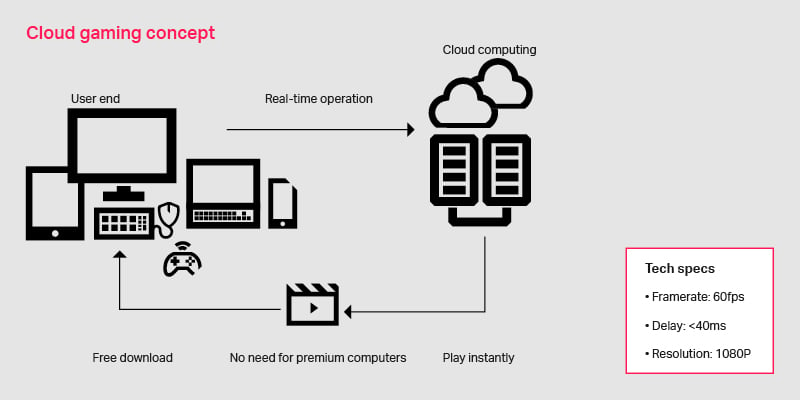- 13 February 2023
- Ted Hazell
When streaming film and TV services were first introduced in 2007 not many believed it would take over in the way that it has. Yet today, when it comes to consuming the latest television, films, and music streaming is the default option for millions of people around the world, with numerous streaming services vying for our collective attention.
The global film and entertainment market, for all types of media, is estimated at approximately 90 billion U.S. dollars in 2021 – which is a lot. However, at an estimated 180.3 billion U.S. dollars, the global video gaming market by 2021, is even larger. Which begs the question: why hasn’t the video game industry followed the lead of the TV and film industry in offering games over streaming? Why aren’t they placing cloud gaming at the forefront of their strategy?
That’s not to say that there hasn’t been rapid development of the cloud gaming market in recent years. In 2021, the cloud gaming market surpassed 1 billion U.S. dollars in value and is continuing to grow with the market expected to be valued at over 21 billion U.S. dollars by 2030. While it may be lagging TV and film, it’s not unreasonable to expect that cloud gaming will eventually become mainstream, thus changing the future of gaming forever.
In our white paper, “The Rise of Cloud Gaming: Changing the Dynamic for Data Centre Gaming,” we look at what cloud gaming is, its use cases and benefits, as well as the technical issues to consider when looking to create a cost-effective cloud gaming service.
What is cloud gaming?
Cloud gaming is when a video game is streamed from a remote server, typically a data centre, to a local device. The game is rendered and played on your local device, and you are then able to interact with everything as if it were local, like a download or a physical disc inserted into your device.
This eliminates the need to download and install games onto a PC, console, or mobile device, allowing for on-demand gaming on lower-cost hardware. To be effective, it requires a dependable, strong, high-speed, low-latency internet connection.

In most cases, cloud gaming requires a monthly or yearly subscription fee to access the content. Certain services will require the purchase of games in addition to the service access price or, in some cases, will make purchased games from the same company available via a cloud service.
Cloud gaming services frequently offer dedicated or web-based applications for streaming games. If using a device that does not natively come with a controller, most devices that allow cloud gaming will allow compatible video game controllers to be connected via Bluetooth or use the standard mouse and keyboard setup. In some cases, where a touchscreen is available, you may have the option to use on-screen controls.
Why cloud gaming is the future
Cloud gaming offers many benefits to players, making it a convenient and cost-effective way to play games.
One of the main reasons why cloud gaming is the future is its accessibility. With cloud gaming, consumers can play games that are usually not possible on devices with limited hardware capabilities, such as low-end PCs, laptops, smartphones, and smart TVs. This means that consumers don't need to invest in expensive or high-end gaming hardware to play their favourite games. The number of devices available to a consumer makes cloud gaming an appealing option for consumers. Because of this, games can be played from any location with an internet connection, making it possible to play games on the go. This is especially useful for players who are constantly travelling or who have limited space to store gaming hardware. This caters to both the casual gamer and the more dedicated gamer and enabling that flexibility makes cloud gaming a far more desirable option.
Cloud gaming is also cost-effective, as it eliminates the need to purchase expensive gaming hardware and sometimes even the games themselves. All the processing power for the games is provided by the cloud service. And with subscription services being the norm, players only need to pay a monthly fee to access a typically large library of video games. With big-budget games being released all the time, keeping up with the newest release on the newest piece of hardware can quickly become an expensive hobby. Cloud gaming can help reduce those costs. For example, with Microsoft’s Game Pass service, many of its first-party titles are made available “day one” and that includes access via cloud gaming.
When it comes to first-party titles, or games created and owned by the company in question, cloud gaming allows for greater compatibility between games that would otherwise be limited to a single piece of hardware. This allows you to play the newest title on your smartphone or laptop instead of using the gaming console for which it was originally created.
Cloud gaming offers a more convenient, flexible, and cost-effective gaming experience for consumers. With its many benefits, it is no wonder that cloud gaming has become an increasingly popular way to play games and is the future of gaming for us.
Why cloud gaming isn't everyone's first choice
Cloud gaming, like any technology, has its disadvantages. While it offers benefits, it also has drawbacks that must be considered.
One of the main drawbacks for many when it comes to cloud gaming is internet dependency. Cloud gaming relies heavily on a stable and fast internet connection. A robust internet connection is not available to everyone, and if a player has poor internet connectivity, it can result in lag, stuttering, and a poor gaming experience. While 5G network coverage is expanding and superfast internet is becoming more available, this doesn't necessarily mean everyone has instant access to it, meaning that for those in question, cloud gaming just isn't viable.
Along with potential connectivity issues, latency becomes an issue too. Latency is the delay between the player's actions and the game's response. The distance between the player and the server can impact latency, causing a delay in the movement of the player and the response of the game. This can make many games, which typically require quick reactions and reflexes—especially when playing online with others—more difficult to play and negatively impact that experience.
While cloud gaming is growing at a fast pace, not all games are available on cloud gaming platforms, and some popular games may not be supported at all. This can be frustrating for players who want to play a specific game but find that it is not available on their chosen platform. With the expected trajectory of cloud gaming, this problem could one day be solved; however, for now, you will be limited to what your chosen service can provide you.
Finally, dependence on the service provider can be seen as a disadvantage of cloud gaming. Consumers are wholly dependent on the service provider for the availability and quality of the games. If the provider experiences technical difficulties or shuts down, players may lose access to their games and progress. Especially when you are investing time and money into a service or specific game, that you technically do not own, it can be frustrating to know that it could be taken away at any time.
While cloud gaming does offer many benefits and will continue to add to and improve upon them in the future, it also has several disadvantages that players should be aware of. The impact of these will vary depending on the consumer's internet connection, technical skills, and personal preferences.
The future is cloud gaming
Just like how giant companies such as Netflix and Spotify have disrupted the film, TV, and music industries, cloud gaming has the potential to do the same with the video game industry—by changing how games are delivered, created, and played.
The cloud gaming market is unlikely to completely replace on-device gaming any time soon; however, with the growth of internet connection capabilities, scalability of gaming, improvements on GPUs, and cloud gaming architecture, there is no reason why cloud gaming can’t become the go-to method of gaming for the masses.
For a more in-depth look at cloud gaming and how Imagination’s low-power, high-efficiency, and high-performance GPU are changing the dynamic for cloud gaming, download and read our white paper, "The Rise of Cloud Gaming."






